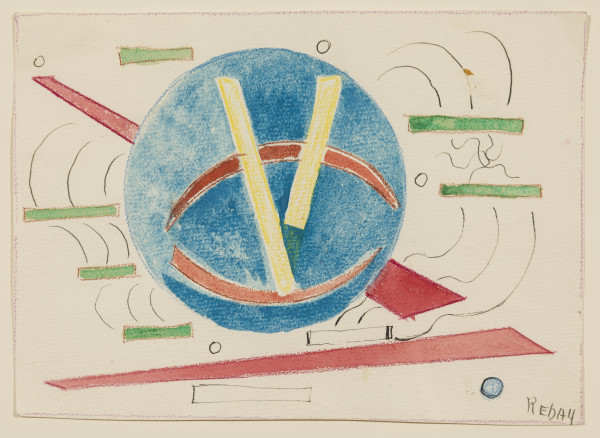-
Artist: Hilla Rebay (American (born in Germany), 1890-1967)
“Hilla Rebay (Baroness Hilla Rebay von Ehrenwiesen) was born in 1890 in Strasbourg, Alsace, then part of Germany.” (1)
“Her father, a career army officer from Bavaria, and her mother encouraged her obvious childhood art talent.” (2)
“Rebay was artistically gifted from an early age, particularly as a portrait painter. She was also profoundly interested in spirituality, and from age 14 explored Theosophy, Buddhism, Zoroastrianism, and astrology. In 1908 she began formal artistic studies at Cologne’s Kunstgewerbeschule, moved to Paris a year later and enrolled at the Académie Julian, and the following year, to Munich to study at the progressive Debschitz-Schule. A decade before the Bauhaus, Debschitz did not divide students by gender, and intermingled fine and graphic arts in its curriculum. It had a strong relationship with avant-garde art, counting Ernst Ludwig Kirchner and Sophie Taeuber (later Taeuber-Arp) among its former students and Paul Klee as an instructor for a brief period.” (3)
“By 1914, she was exhibiting with the Secession Group in Munich, the Salon des Independants in Paris, and the November Gruppe in Berlin--all rebelling against prevalent realism and traditional teaching methods. In Berlin, she associated with many modernist artists including Vasily Kandinsky, Paul Klee, and Marc Chagall.” (2)
“In 1915 she met fellow Alsatian artist Jean Arp, with whom she began a two-year platonic relationship, and who introduced her to the works of artists like Wassily Kandinsky, Franz Marc, Paul Klee, Marc Chagall and Rudolf Bauer.” (4)
“In 1917, she met Rudolph Bauer, a German painter in non-objective styles who became her long-time lover and in the future the cause of controversy because she was accused of devoting disproportionate exhibition space to him at the Guggenheim Museum.” (2)
“In the winter of 1916/17 Rebay met Berlin-based gallery owner Herwarth Walden. And only a short while later, namely the summer of 1917 saw her taking part in the 53rd STORM exhibition. Alongside a series of sketches, she exhibited the painting ‘Komposition I’ – a concentrate, non-figurative piece entirely her own, which was primarily executed in red and green.” (4)
“In 1918 she exhibited with the Novembergruppe, and in 1919 Rebay and Bauer moved in to a shared studio in Berlin.” (1)
“Hilla Rebay first visited the United States in 1927 and stayed for an extended time period, which included giving painting lessons to Louise Nevelson, seeking portrait commissions, designing posters and exhibiting her own work at venues including the Worcester Art Mluseum [sic] and a Manhattan gallery.” (2)
“Rebay brought some of Bauer’s work with her. They were hanging on the walls of her studio when Guggenheim sat for a portrait by her around 1928, and he took an interest in the work. The two formed a friendship, and Rebay convinced him to collect some works by Bauer. This was the starting point of a lifelong personal and professional relationship.” (3)
“Rebay and Guggenheim first created the Museum of Non-objective Painting in 1940 in a remodeled space on East 54th Street in New York City, while searching for an architect for a permanent museum. As evidenced by their correspondence Rebay and Frank Lloyd Wright became good friends over the years from 1943 when he began the museum’s design through 1959 when the current Guggenheim Museum was completed.” (5)
“In 1951, two years after Guggenheim's death, Hilla Rebay resigned as Director but remained a trustee of the collection, and lived in Greens Farms, Connecticut. During her career as an administrator, she had continued as a painter and created canvases of geometric shapes and ones that expressed pure color and rhythm. She also authored several books including one titled ‘Wassily Kandinsky’, and wrote articles for the ‘Carnegie Institute Magazine’ and ‘Southern Literary Digest.’ However, her enduring reputation is for her influence in bringing non-objective art to America.” (2)
“Rebay was replaced as director by James Johnson Sweeney.” (1)
“After her death in 1967, part of Rebay’s estate—including works by Bauer, Alexander Calder, Albert Gleizes, Kandinsky, Klee, Piet Mondrian, and Kurt Schwitters—joined the Guggenheim’s permanent collection.” (3)
Reference
1. Spanierman Modern Staff. Hilla Rebay [internet]. New York, NY: Spanierman Modern [cited 2019 Dec 16]. Available from: http://www.spaniermanmodern.com/artists/hilla-rebay
2. Askart Staff. Hilla Rebay [internet]. [cited 2019 Dec 16]. Available from: https://www.askart.com/artist_bio/Hilla_Anna_Rebay/30976/Hilla_Anna_Rebay.aspx
3. Guggenheim Staff. Hilla Rebay [internet]. Guggenheim Museum; 2019 [cited 2019 Dec 16]. Available from: https://www.guggenheim.org/history/hilla-rebay
4. Tanner, E. Hilla von Rebay: Art For Peace [internet]. Schirn Magazine [cited 2019 Dec 16]. Available from: https://www.schirn.de/en/magazine/context/hilla_von_rebay_art_for_peace/
5. Mickelson, J. Hilla Rebay: In Search of the Spirit in Art [internet]. McFarland & Company, Inc.; 2013 [cited 2019 Dec 16]. Available from: http://www.joanmickelsonlukach.com/hilla_rebay__in_search_of_the_spirit_in_art_63259.htm
